
Featured Articles
Accretion Desk by Martin Horejsi Jim's Fragments by Jim Tobin Micro Visions by John Kashuba Mitch's Universe by Mitch Noda MeteoriteWriting by Michael Kelly


Accretion Desk by Martin Horejsi Jim's Fragments by Jim Tobin Micro Visions by John Kashuba Mitch's Universe by Mitch Noda MeteoriteWriting by Michael Kelly
Materials contained in and linked to from this website do not necessarily reflect the views or opinions of The Meteorite Exchange, Inc., nor those of any person connected therewith. In no event shall The Meteorite Exchange, Inc. be responsible for, nor liable for, exposure to any such material in any form by any person or persons, whether written, graphic, audio or otherwise, presented on this or by any other website, web page or other cyber location linked to from this website. The Meteorite Exchange, Inc. does not endorse, edit nor hold any copyright interest in any material found on any website, web page or other cyber location linked to from this website.
The Meteorite Exchange, Inc. shall not be held liable for any misinformation by any author, dealer and or seller. In no event will The Meteorite Exchange, Inc. be liable for any damages, including any loss of profits, lost savings, or any other commercial damage, including but not limited to special, consequential, or other damages arising out of this service.
© Copyright 2002–2023 The Meteorite Exchange, Inc. All rights reserved.
No reproduction of copyrighted material is allowed by any means without prior written permission of the copyright owner.

With a degree in geosciences from Princeton, author Yinan Wang brought the magic and wonder of gems, minerals, and fossils to the young adult masses through a pair of books using “The 50 State'' theme. And now in a third book, meteorites join the fold with the new book The 50 State Unofficial Meteorites: A Guidebook for Aspiring Meteoriticists.
The 80 pages of color photos present meteorites found around America with each state represented whether or not the state can claim a meteorite fall or discovery of its own. But what really makes this book stand out in the realm of youth literature about meteorites is the quality of the explanations across a wide scope of meteorite and scientific topics. But not with lengthy, detailed, dense paragraphs of text, but with concise, to the point explanations that answer the question without wandering into the gory details that we learn to love as collectors.
The first dozen pages of this hardcover book would make an exceptional introduction to meteorite science on their own. But the bulk of the book is a deeper tour through the nuances of meteorites themed across each state’s contribution to our collections.
“The
Before the reader knows it, they will have a significantly better than average understanding of complexities of meteorite history, meteorite science and the connection between meteorites and planetary geology. In fact, I would be happy if graduate students in geology had the background knowledge in this book. It’s that good.
The Twodot meteorite is an oriented stone so the mushroom-shaped head should point towards the earth. That is something I mentioned to the author, and I'm glad it was presented that way.

The publisher’s description of the book is as follows:
Delve into this unique look at meteorites that have been found in almost each of the 50 US states, and discover how these treasured rocks from space fell down to Earth.
With each state entry, award-winning author and mineral and fossil expert Yinan Wang presents details about several meteorites that are worthy of becoming official state meteorites. Since no state has an official state meteorite, this kids' guidebook explores each state's “unofficial” meteorite, along with its interesting backstory of why it was selected.
• More than 150 illustrations and photographs showcase these marvels from outer space
• Meteorites have not been found in all states so helpful suggestions are given on where they might be found
• Suggestions and guidance are provided so that the reader can lead the way in getting one designated
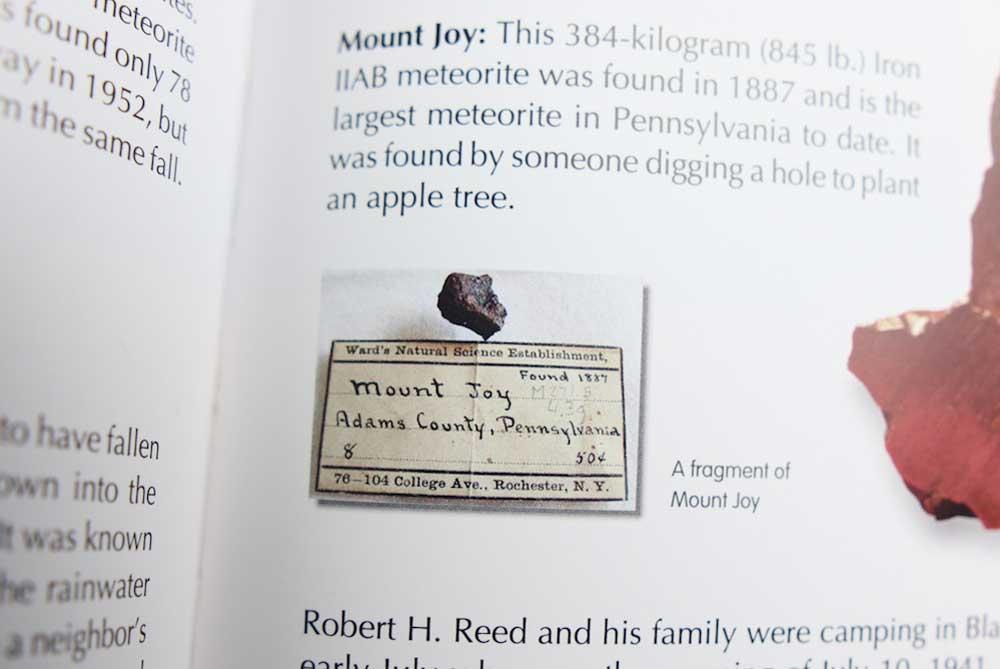
From the Lafayette Mars meteorite found in a drawer in Purdue University to the 26-pound space rock that smashed into the trunk of a car in Peekskill, New York, immerse young science students in an encyclopedic yet easy read that is great for aspiring meteoriticists.
One of the images used in the book has been sitting quietly on a digital shelf for over two decades. I'm glad it is back in the sunlight.
With the loss of so many of our meteorite book authors over recent years, it is both refreshing and important to continue the literary contributions about meteorites referencing our current science and most of all, our current interests. I just know that some young readers of The 50 State Unofficial Meteorites: A Guidebook for Aspiring Meteoriticists will cite this book as the turning point when they decided to become a member of the next generation of practicing meteorite scientists.
Until next time…
As 2023 starts Jason Phillips and I have another meteorite well along the classification trail. It is suspected at present to be a howardite or polymict eucrite. Back in late October Jason contacted me and asked if I was interested in doing another of our fun classification projects. I of course asked a couple of questions and then enthusiastically said yes. I sent him half of the money to get the meteorite to America. From the images, we received from the owner it was obvious that it was a genuine meteorite. It was the second week of November when I received the stone from Jason. It had a covering of black shiny fusion crust on about 80-90% of the surface. The fusion crust was itself covered in caliche which concealed the beauty of the fusion crust. It is still concealed for I did not attempt to remove the caliche. I have removed this desert calcium deposit from other meteorites over the years and it works out well, but this time I left the stone alone. We could see large clasts of black mineral in places on the exterior and making an immediate visual assessment that it could be a Howardite was easy.

As is always the case in these projects that I do with Jason the decision about where and how to cut the stone had to be made. There is always an exchange of images and a discussion about how to divide the interesting features. This stone had some great shape and ablation features in a couple of areas and thumbprinting on the surface that we needed to have on both pieces. I made a line with a green chalk crayon and sent an image to Jason. He was happy with my choice of where to cut. I needed to get the weights equal now. I made a more permanent surface to mark a line on because the chalk wipes off very easily. I wrapped a turn of paper tape around the stone. The stone moved to my simple knife edge balance where I line up the intended cut until the meteorite neither tips to the right nor the left. I hold it at that position and make a mark with a felt pen exactly in line with the long knife blade and down vertically on both ends. It is just a matter of connecting the line along the bottom. The knife edge is an old piece of die-cutting rule from my printing days. I mounted it between reinforcing strips of wood to keep it
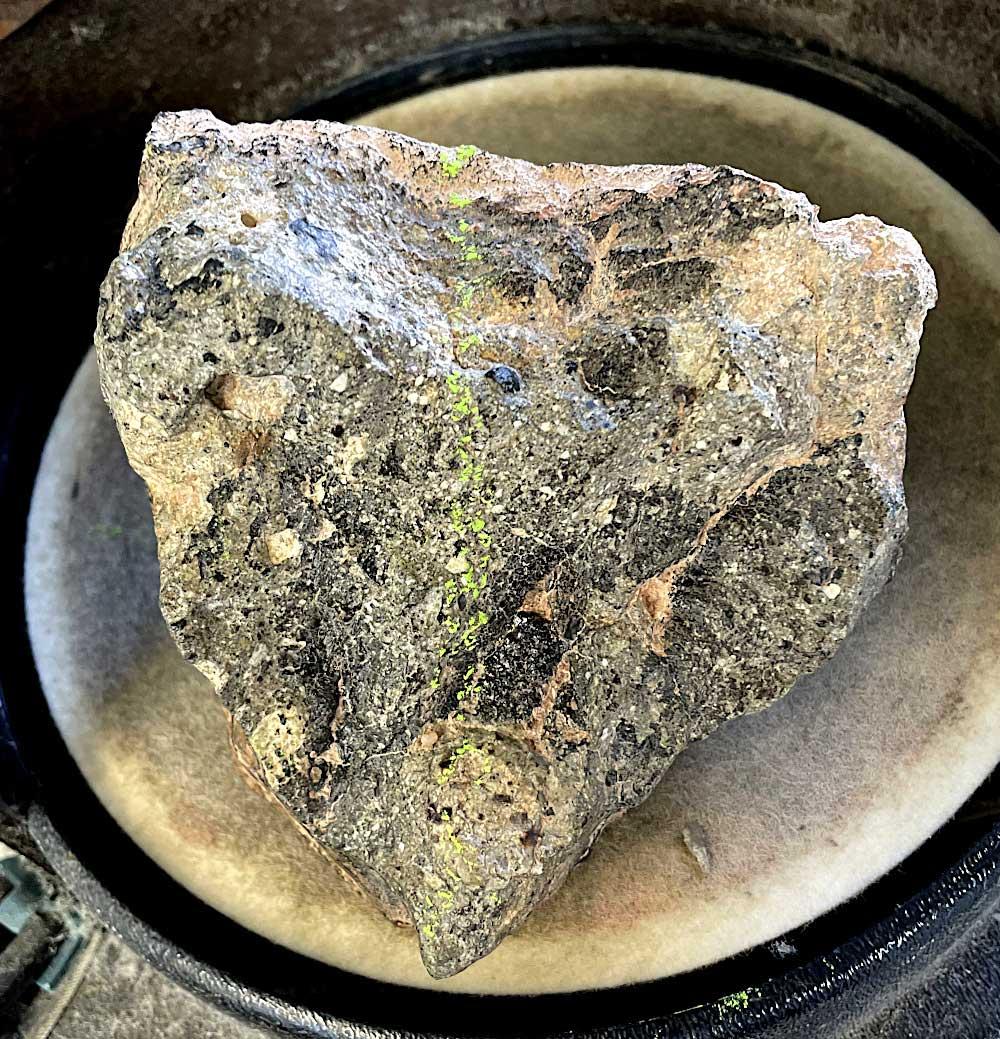
stiff. Clamped in a machinist vice the knife edge balance sits steadily on a table.
Now that I know where the point of balance and equal weight is I have the hardest job to do. That is to guess how much to shift the dividing cut to have extra on one-half equal to the weight of the type specimen which is a minimum of 20 grams. Sometimes the meteorites are not special and a 20-gram piece can be cut off almost anywhere from a rough stone. But this stone was nice and neither of us wanted an extra cut on the fusion-crusted exterior. Also and maybe the most important consideration in this case was that it was a likely Howardite or polymict eucrite and it was important to send as much information as possible. The last thing you ever want to do with these achondrite types of meteorites is to send a type specimen that only represents part of the material. It has happened in the past that meteorites were classified as one type but if a more representative specimen had been sent it would have been classified as something else. I did not want the Howardite possibility to be overlooked by sending just eucritic material. So a full slice was desirable to send. However, I did not want to give up too much material either. So it required a hard guess on how much to shift over the first cut and how thick to make the type specimen slice. The following images show how much I shifted the cut from the perfect balance point and there is a close-up image of the stone in the saw with the thin blade. After that is an image of the removed type specimen slice in my hand. The type specimen is quite thin and fragile but would represent the entire character of the meteorite. The type specimen slice weighed 24 grams, about as close as anyone could wish. Being fragile I took great care packing it for shipment to the classifier.



With two cuts I had our halves of nearly equal weight and the type specimen slice. It was an impressive-looking achondrite. The large black inclusion was interesting and the mineral crystal with the web of thin white bars was something for me to investigate in the future.

Now it was just a matter of finishing the halves to a fine highly polished state. I lapped the faces on a 260-grit diamond disc to remove the cut marks. A 600-grit disc smoothed the surface on each half almost enough but I went on to 1500 grit to make still nicer surfaces. Finally, a long polishing with 100K mesh diamond on a felt disc gave the faces a mirror-bright look. I packed up Jason's half and sent it off. I sent off the type specimen and we began the wait to hear what kind of meteorite we have. That wait continues but it has only been about two months as of this writing so not very long yet. I am hoping for the Howardite classification and the large black clasts encourage that hope. But another eucrite would be good too. It is an attractive meteorite and so far has been another fun project with Jason Phillips. I always look forward to seeing him at Tucson each year but unfortunately, I won't be attending this year. These little meteorite classification projects do help to keep us in touch.

This is the finished half of the meteorite in my collection. It weighs in at 544 grams. There was very little waste created in the cutting and lapping. Comparing the type specimen image and this image of my half you can see how fast the big black clast was disappearing with even the very thin slice I cut off for the type specimen. One more thin slice and don't think there would even have been any more of the large black clast which I feel is important for the classification. So luck favored where we made the split of the meteorite.

Many chondrules consist of phenocrysts embedded in a glassy mesostasis. Sometimes the interstitial glass will have been annealed to such an extent that it will have become devitrified through solid state diffusion into distinctly crystalline laths. Here we will look at one of each type.
Both are in this thin section of an L3.2 ordinary chondrite.

The first, the one with the glassy mesostasis, in on the left. The annealed chondrule is on the right.

In cross-polarized light, XPL, all glass will be black.



Outside the chondrule, lower left, the matrix is opaque. Inside the chondrule the glass passes some light. Where the mesostasis is thin, as when it lies over an olivine crystal, we see that it contains fine crystallites.


Crystallites. XPL FOV = 0.3mm.


Crystallites. XPL FOV = 0.3mm.

The other chondrule in cross-polarized light shows black portions but these are simply mineral grains that are in optical extinction.

Chondrule is about 3mm in diameter.

In PPL the only black is minor opaque minerals. Some brown staining encroaches from the surrounding matrix.

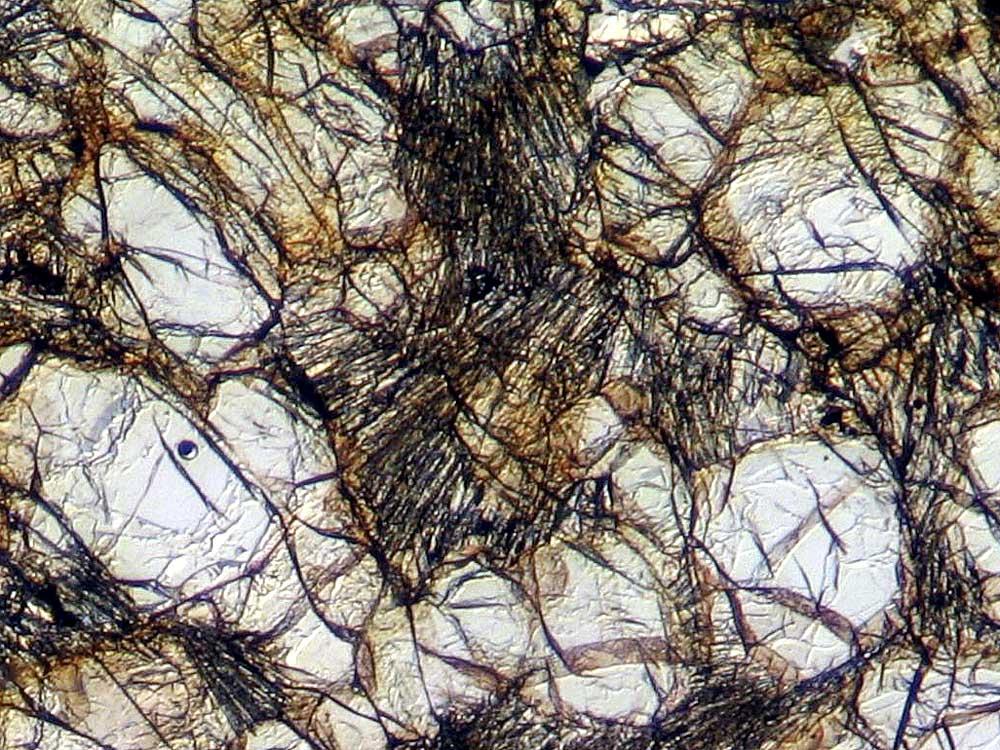
Interstitial glass has become fibrous crystals. XPL.
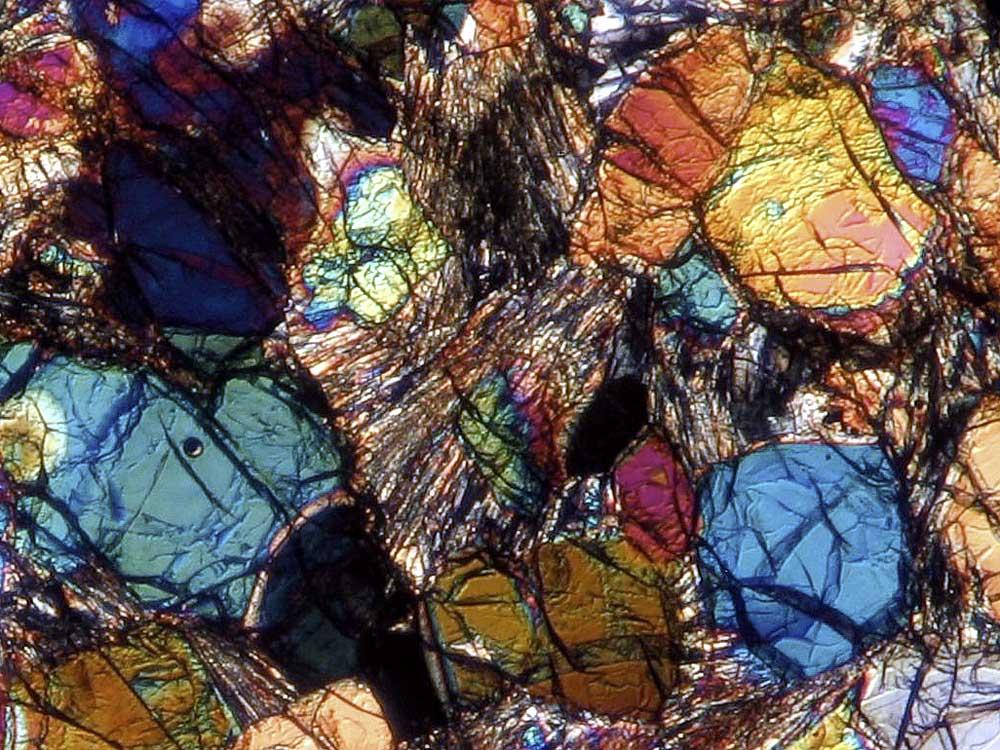


 Mitch Noda
Mitch Noda
The fall of L’Aigle, in 26 April 1803, is commonly regarded as the event that turned skeptics into believers that stones do fall from the sky; however, Siena which fell almost a decade earlier, on 16 June 1794, set in motion the belief that stones fall from the sky, and the inception of meteoritics.
L’Aigle, one of the most important historic meteorites that many regarded as the one that turned skeptics into believers that stones do fall from the sky. This 20 gram extraordinary specimen with patches of dark fusion crust was once in the Academy of Natural Sciences museum collection in Philadelphia. It was in my friend Mike Bandli and then in my collection of meteorites before being deaccessioned. Photo courtesy of M. Bandli.
Historians have often argued that L'Aigle in the French province of Normandy in 1803, sparked the early investigation of meteorites. Dr. Ursula B. Marvin of the Smithsonian Astrophysical Observatory and former president of the Meteoritical Society, presented evidence that the modern science of meteoritics had its roots in the Siena, Italy fall, nine years earlier than L’Aigle. Before Siena, few believed that a shower of stones could come from the sky or at least consider it.
Siena was the first meteorite fall to occur in the vicinity of a sizeable European city, and the first meteorite to be witnessed by so many people, including English visitors, that the fall of the stones from the sky could not be denied. James Smithson of England, whose bequest led to the founding of the Smithsonian Institute, wrote a convincing report about Siena. Smithson happened to be in Florence and immediately headed to Siena upon hearing of the phenomenon. Smithson extensively interviewed local residents, and he reported it to Henry Cavendish, the British scientist who discovered hydrogen. At the time, almost no one believed rocks fell from the sky, it defies physics, and Frederick A. Hervey, Earl of Bristol, visiting Siena after the fall commented, "My first objection was to the fact itself [stones falling from the sky], but of this there are so many eyewitnesses, it seems impossible to withstand their evidence." When subsequent meteorite falls were reported, such testimony was treated in Europe with less skepticism – except in France, where a number of highly regarded scientists remained unconvinced. Siena also was the first fall to be seriously investigated by scholars, at several universities in Italy, who collected eye-witness reports and specimens and formulated hypotheses of its origin. Their task was greatly complicated by the timing of the fall which occurred 18 hours after the eruption of Mount Vesuvius. Some believed that the two events

were entirely coincidental; others thought that the stones were ejecta from the volcano (which was about 320 km (199 miles) from Siena and explained why rocks were burned and fell from the sky). No explanations seemed entirely satisfactory, but the well-observed fall at Siena opened a new dialog on this subject.
2.18 gram Siena meteorite from the University of Babes-Bolyai (Romania) collection with its number painted on it, and number label attached to it. It is resting on a catalogue of the University’s collection referencing the I/46 Siena number. This sublime piece of Siena now resides in my collection after being deaccessioned from friends Mike Bandli and Arnaud Mignan (Tricottet Collection) very cool collections. According to Marvin, it is the most consequential of historic falls. Photo courtesy of M. Bandli.

Afterwards, skeptics could no longer dismiss accounts of falling rocks as the tall tales of unschooled peasants, notes Marvin. For these reasons, the Siena event represents the most significant fall in modern times, Marvin asserted at an annual meeting of the Meteoritical Society in Washington, D.C. Thus, says Marvin, "the fall at Siena began a line of investigations that led to acceptance of Chladni's hypothesis in 1802--a full year before the famous showers of 3,000 stones in Normandy.”
Marvin boldly claims, "That is why I conclude that Siena was the most consequential of historic
meteorite falls." I concur with Marvin.
My historic Siena meteorite resting on a historic Universitatea Babe-Bolyai label. The BabesBolyai University, which began in 1581, is a public research university located in Cluj-Napoca, Romania. It is the largest university in Romania with about 50,000 students and ranked number one in Romania by the Romanian Ministry of Education. In 1959, the Romanian and Hungarian language universities in Cluj merged to form the Babes-Bolyai University. Photo courtesy M. Bandli. About a year after Siena, the case for fallen stones was further strengthened by the fall at Wold Cottage in Yorkshire, England, on 13 December 1795. In 1796, Edward King, a Fellow of the Royal Society, published the first book in English on fallen stones. In it, he focused primarily on the Siena event, including Soldani’s book, and mentioned Wold Cottage. King's 36-page book was widely read.
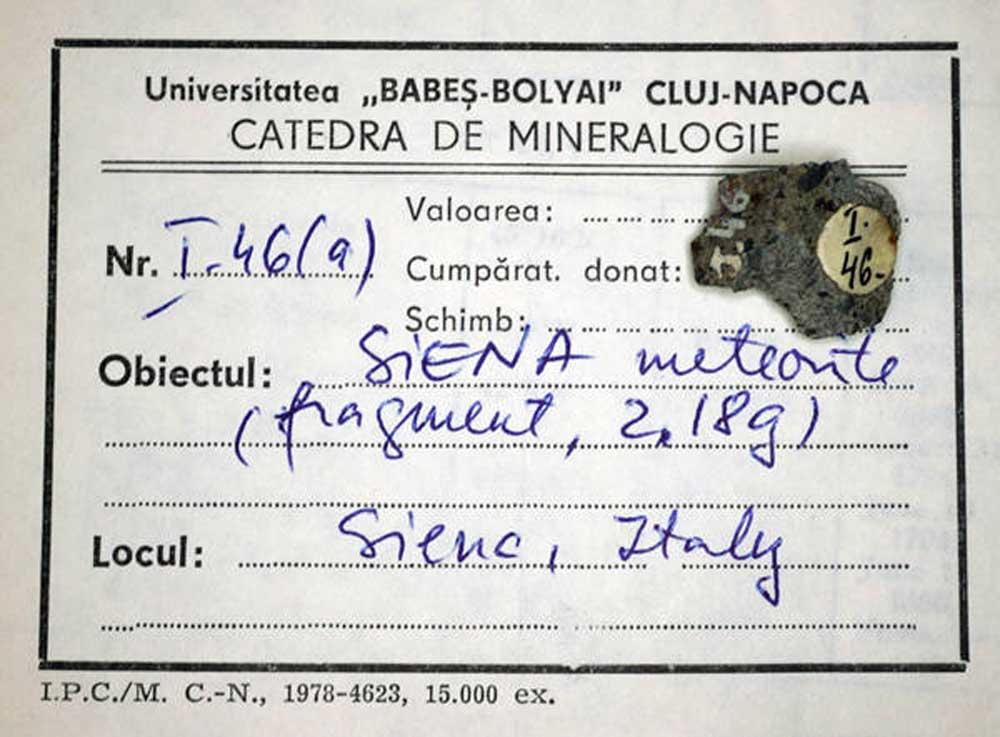
My superb 7.4 gram partial slice of Wold Cottage with black fusion crust deaccessioned from Mike Bandli’s sublime collection. Another meteorite with a significant place in history. Photo courtesy of M. Bandli.

Wold Cottage partial slice with British Museum lineage resting on a copy of the British Museum label with hand written note about exchange with Dr. Jim Schwade. Mike Bandli recounts, “In 1990, Dr. Jim Schwade exchanged a large sample of Caddo County iron for a 69.32 gram thick, triangular part-slice of Wold Cottage from the British Museum (BM #1073). This specimen is cut from that piece.” Photo courtesy of M. Bandli.
Wold Cottage and similar events convinced Sir Joseph Banks, President of the Royal Society, that an investigation was warranted. He asked Edward Howard, a young chemist, to analyze the chemical composition of the alleged rocks from the sky. Howard read Chladni's book and began acquiring samples of the stones and iron masses. Working with the French mineralogist Jacques-Louis de Bournon, he made the first thorough scientific analysis of meteorites and eventually confirmed Chladni's work and his status as the father of meteoritics.

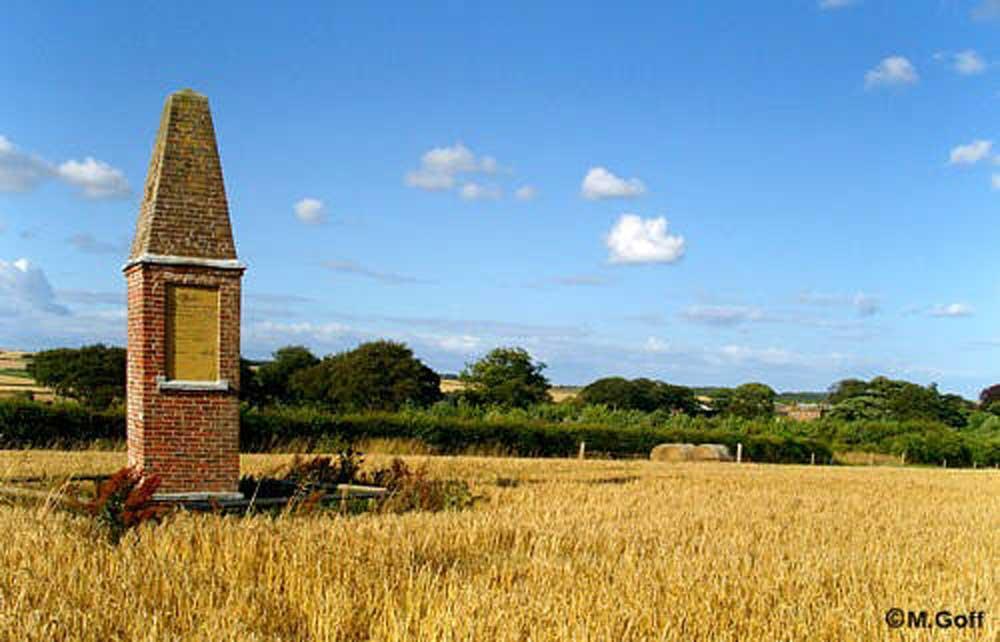
Mike Bandli writes in his website, Historicmeteorites.com, “Monument meets stone. A 200+ year old brick fragment and piece of the original Wold Cottage monument erected by Captain Edward Tophamin 1799. Fragment was removed in 1999 as part of the monument’s restoration and taken with permission. Ex. Rob Elliott Collection.” Photo courtesy of M. Bandli.
In 26 April 1803, L’Aigle was witnessed to fall by numerous prominent citizens including political leaders and business owners. Jean Baptiste-Biot, a French scientist, was commissioned to study the event and presented evidence to the French Academy of Science. His comprehensive report that included the first strewn field map on record, was the tipping point for Academy’s acceptance that rocks fall from space. Soldani, King and Chladni, father of meteoritics, were the first to write that rocks fell from the sky, but it was Baptiste-Biot whose report was accepted by the scientific community, including the French who had enormous influence as to what was accepted, that started the acceptance that rocks fall from the sky. These events earned L’Aigle a rightful place in meteoritic history. Soldani and Chladni’s books were ridiculed when they were first published. The combination of the thoroughness of BaptisteBiot’s report and the large number of credible witnesses led to L’Aigle being the fall in which the scientific community accepted that rocks fall from space. It probably did not hurt that Baptiste-Biot was French to convince the French scientific critics. It should be noted that Baptiste-Biot was not completely accurate since he speculated that the stones and irons came from volcanoes on the moon, but he should be forgiven since he was pivotal in the scientific community starting to accept that rocks fall from the sky at the dawn of meteoritics.

My copy of Abbe Ambrogio Soldani’s book “Sopra una pioggetta di sassi accaduta nella sera de' 16 Giugno del MDCCXCIV” (“Over a Shower of Stones Which Occurred on the Eveneing of 16 June 1794”). The book in my opinion is practically unattainable. There are more copies of the Gutenberg Bible or U.S. Constitution, then of the original Soldani book on the Siena fall. Photo courtesy M. Bandli.

Title page of Soldani’s book.
Excerpt from my friend, Mike Bandli’s Historic Meteorites.com website about Abbe Ambrogio

Soldani’s book “Sopra una pioggetta di sassi accaduta nella sera de' 16 Giugno del MDCCXCIV” (“Over a Shower of Stones Which Occurred on the Eveneing of 16 June 1794”) which is part of my library collection, and deaccessioned from Mike Bandli’s library collection.
When it comes to early books on meteorites, few are rarer than Soldani’s dissertation on the fall of stones in Siena, Italy in 1794. The fall at Siena and subsequent publication of Soldani’s book were part of a decade long chain of events that helped propel the idea and acceptance that stones could fall from the sky.
In September 1794, only three months after the fall at Siena, Soldani published his 288-page treatise, which included sworn testimonies from eyewitnesses, distribution and descriptions of stones, and a fold-out plate with beautiful line-art engravings. In the end, Soldani concluded that the Sienese stones were of atmospheric origin and were of no relation to volcanism. [Soldani incorrectly concluded that the stones had "congealed" in the high, dark cloud and had no link to the eruption of Vesuvius, but he correctly deduced that stones fall from the sky.] Despite being wrong, Soldani’s work, along with the important works of Chladni, King, Howard, and Biot, would contribute to the founding of a new science – Meteoritics.
After nearly a decade of searching, we finally located an original copy of Soldani’s book. Soldani’s book is more than rare – it is absolutely scarce. WorldCat lists only six original copies preserved worldwide, including those in the prestigious libraries of the Smithsonian and the Museum of Natural History, Paris. Through extensive resources, we were able to identify only one other copy in a private Italian collection, bringing the total, including our own, to eight known copies. [There are more copies of the Gutenberg Bible or U.S. Constitution, then of the original Soldani book on the Siena fall.]
Below we present the stunning line-art drawing contained in Soldani’s book. The large fold-out plate is titled “Stones fallen from the stormy cloud on the 16th of June, 1794.” The plate depicts five of the Sienese meteorites as well as the “high dark cloud” that appeared during the fall. For many scholars, this was the first time seeing the depiction of a meteorite.
hand drawn renditions of the Siena meteorite and clouds. Photo courtesy of M. Bandli. The provenance of the antiquarian books can often be as fascinating as the book itself. It turns out that our particular book has quite an interesting history. First, if we examine the title page, we will see a curious 18th century stamp (shown below): “Bibl. S. Eremi Camald.” The Bibliotheca S. eremi Camaldolensi, or the Library of the Hemitage of Camaldoli, was established in the year 1622. According to ItalyThisWay.com, the library “has a coffered ceiling including paintings depicting the Evangelists, the Apostles Peter and Paul, SS. Fathers Benedict and Romuald, the Fathers and Doctors of the Eastern and Western Churches, and the thinkers of the Benedicting Order.” Needless to say, it is a fascinating to think that our book once rested on such historic shelves during part of the 18th and 19th century. As an interesting side note, the Hermitage itself is celebrating its 1,000 year anniversary this year (1012-2012).

18th century stamp of the Hemitage of Camaldoli library inside my copy of Soldani’s book. Photo courtesy of M. Bandli.
Some 80 years later, our book would continue its journey to the library of noted Italian naturalist and paleontologist Roberto Massimo Lawley (1818-1881) at Montecchio, as confirmed by his own private library stamp shown below. Photo courtesy of M. Bandli.
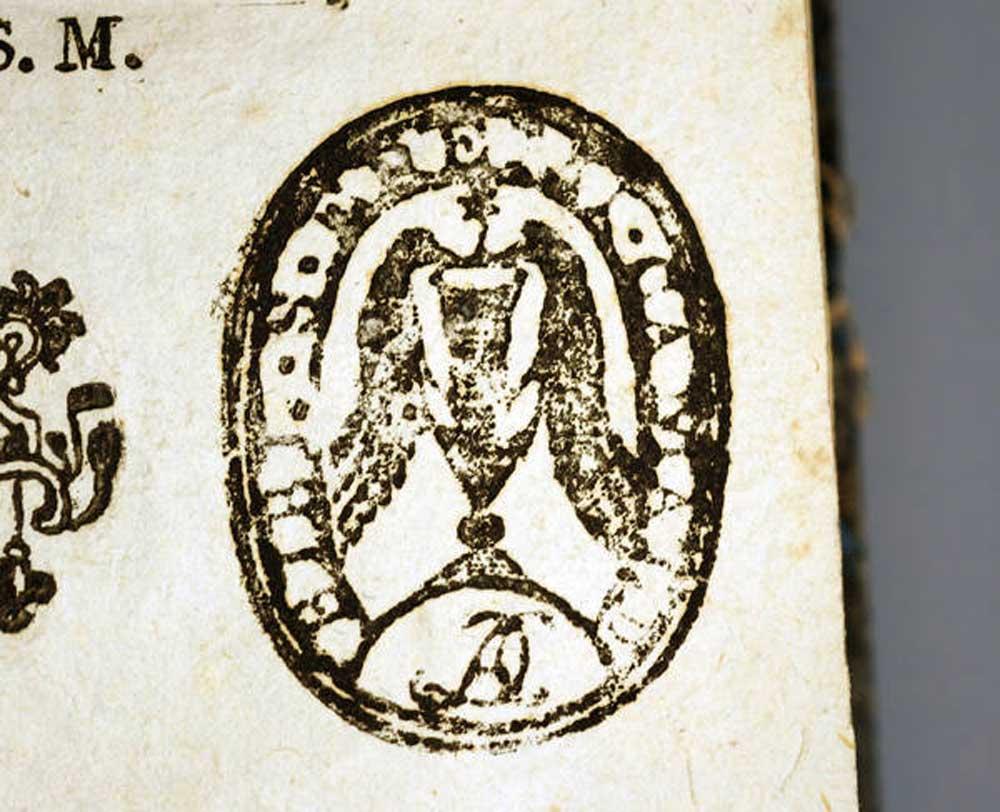
Behind the last page and fold-out engraving are 24 pages of Italian manuscript regarding the fall of Siena and Soldani’s book. Paolo del Santo at the Institute and Museum of History and Science of Florence shed light on the handwritten manuscript in Soldani’s book. It was anonymous and written by a merciless detractor, a mudslinger who contests, point by point and in a very caustic and sarcastic way, Soldani's theory according to which the stones would have been generated in the clouds. The anonymous person writes, "On the contrary of the author [Soldani], we poor narrow-minded can't see the pyramidal or prismatic sharp of the stones fallen from the cloud, because to see that one needs to be a mathematician, like Soldani, and to have a microscope [with reference to the microscope to which Soldani refers in the introduction of his book, and given to him by Frederick A. Hervey, 4th Earl of Bristol]."

A handwritten manuscript written by an anonymous critic found inside Soldani’s book. Photo courtesy of M. Bandli.
I wonder why Soldani would keep such a document? Did he keep it to remind him that this was the common belief he had to overcome or to preserve a piece of history that Soldani knew time would eventually prove wrong?
Since the document was directed at Soldani, could the book in my library collection at one time belonged to Soldani? Why else would a manuscript intended for Soldani be inside this book?

A handwritten manuscript probably written by a wealthy, educated person who knew what a microscope was back then. The literacy rate in Italy in the 18th century was very low, therefore, the document was probably not written by an ordinary person. Photo courtesy M. Bandli.

Ursula Marvin notes that Soldanite, named after Soldani, may well have been "the first official name for meteoritic stone."
Krasnoyarsk (Krasnojarsk) was the first pallasite ever found that was studied for the first time as a meteorite in 1794 by Ernst Chladni, and led to the creation of the Pallasite group named after Pyotr Pallas. Krasnoyarsk is sometimes called the Pallas iron, the name given to it by Ernst Chladni. In 1794, two months prior to the fall in Siena, Ernst F. F. Chladni, a German physicist, published Ueber den Ursprung der von Pallas gefundenen und anderer ihr ahnlicher Eisenmassen und uber einige damit in Verbindung stehende Naturerscheinungen (Concerning the origin of the iron masses found by Pallas and other similar ones, and some natural phenomena connected with them), asserting the heretical notion that stones and masses of iron fall from the sky and deserve recognition as natural phenomena. He asserted that the falling masses might create fireballs in the atmosphere or even originate in “cosmic space.” These ideas violated a two thousand year old belief – first claimed by Aristotle, and later by Newton: except for stars, planets, moons, and comets, space was empty, and rocks do not fall from the sky. From the beginning, Chladni was severely criticized for basing his hypothesis on historical eyewitness reports of falls which others regarded as folk tales and for taking gross liberties with the laws of physics.
It would take the Siena, Wold Cottage and L’Aigle falls and the work of Soldani, Baptiste-Biot, King and Howard to start the acceptance of Chladni’s theory: that stones and iron fall from the
sky. Those events, meteorites and people, in the arc of history, were the inception of meteoritics.
Acknowledgement:
I would like to thank my friend, Mike Bandli for allowing me to use an excerpt and photos from his Historic Meteorite.com website on the Soldani book about the Siena fall and, photos of Siena, L’Aigle and Wold Cottage meteorites which were a part of his sublime collection. Mike has an extraordinary amount of knowledge and has taught me a lot about historic meteorites and people. I hope I can play it forward and pass along some interesting meteorite history to you. I would also like to thank my friend Martin Goff for allowing me to use his photo of the Wold Cottage monument and providing me links to interesting articles and BBC interview on Wold Cottage. I would like to thank my friend Dr. Arnaud Mignan (Tricottet Collection) for his vast knowledge on historic meteorites and people, and spending time discussing our shared interests. Lastly, I would like to thank my friend Dr. Carleton Moore, for giving me support and encouragement for writing these articles.
References:
Ambrogio Soldani's dissertation on Siena and a newly discovered manuscript on the Siena meteorite (historicmeteorites.com)
Siena, 1794: History's Most Consequential Meteorite Fall by UB Marvin · 1995 https://ui.adsabs.harvard.edu ›
July 2009 Meteorite Times – The Accretion Desk – Martin Horejsi – “A Holy Grail Met With Disbelief”
msg-meteorites.co.uk/meteorite-adventures/a-meteorite-homecoming
msg-meteorites.co.uk/meteorite-adventures/a-meteorite-homecoming-%20media-and-links
Bonhams : Siena Meteorite — Complete Slice of the First Scientifically Accredited Rock from Space
L'Aigle Collection | Falling Rocks Meteorite Collection
After the fall: in 1794, a heavenly epistle heralds the study of meteorites. - Free Online Library (thefreelibrary.com)
Wikipedia – University of Babes-Bolyai
Reddit – Literacy rate in Italy in the 18th century
When I started meteorite collecting I knew all of one thing about meteorites, they are rocks from space. After getting my second, third and fourth meteorite, very shortly after getting my first meteorite, I knew I had to figure out where I was going with collecting meteorites. Early on I ran across an article by Geoff Notkin titled: HOW TO START A METEORITE COLLECTION. The article centered on the different focuses of collecting and after reading about the concept of type collecting, which he described as a monumental undertaking, I knew I had found my calling, monumental undertaking?... challenge accepted!
Several years into the type collecting I ran across a paper that had a decent listing of the known minerals found in meteorites, the paper was a touch dated at that point but it was a good read. So I decided to see just how many of the minerals in meteorites I potentially had represented in the pieces I had. I also decided it was time to flush out that minerals list and then start pursuing pieces to add to the collection that not only filled a meteorite classification type, but those that filled voids in my meteorite minerals types collection. That took a hefty bit of researching along three focus areas: independent research papers, using the MINDAT database, and searching the METBUL. This series will focus on all things types: type falls, type localities, sub types, petrology grades, and types of minerals be they in the meteorites or even terrestrial polymorphs created during impact.
Many individuals in the meteorite community are familiar with the term type fall. The type fall (or more accurately prototype since some of the groups are named after finds) is the location name of a meteorite for which distinct group characteristics are established and all similar meteorites are added to that group and are said to be of the type. Fewer folks may be familiar with the term type locality which is a term used in both geology and the collecting of rocks and minerals. Type locality is a term which centers on capturing and recording the first location from which a unique rock or mineral was identified.
When it comes to type locality vs type fall (prototype) not all things are equal. In most scenarios when it comes to meteorites the first unique fall/find is what the classified group is named after, and would also represent the piece entered as the type locality. However there are some instances where the first of it's kind is passed over during the meteorite group naming acceptance. For instance the Bencubbinites are named after Bencubbin, however this Australian find which gives the group its name was found four years after its fellow group member Weatherford, and links between the two being proposed as having a shared parent body well predate the acceptance of the group under the name Bencubbinites, so one might question why we don’t have Weatherfordites instead, and one could also reasonably say that
Weatherford since studied in the same research could be considered to hold the title type locality though not given the credit for being the prototype. Likewise the very recently formed Loongana group (CL) of Carbonaceous chondrites takes it's name sake from Loongana 001 a 1990 find, while the paper which made the group a reality contains and reclassified Coolidge a 1937 find into the group but did not make it the prototype, which very well might be for no other reason than having a (CC) group designation within the Carbonaceous Chondrites (CC) class might cause a bit of unnecessary head scratching. The Vestian suite of meteorites (howardites, eucrites and diogenites) suffer a similar issue since their names do not derive from the locations of any of their members, and yet there was a first of each that should rightfully be called the type locality. All of these groups will be the subject of articles in this series, to be interspersed with other writing interests (hoping for that next planned article interruption for a fresh U.S. fall!)
Starting off with anything new, it’s always good to kick things off on a high note, so I thought long and hard on a meteorite that has a little bit of everything going on. After a bit of deliberation I decided to highlight Allende. Allende checks off a couple of boxes related to this subject, and is a staple in most serious collections. So hopefully this will have you looking at your Allende in a bit of a new light. Allende all the way back to 1977 as proposed by Harry Mcsween should rightfully be the namesake of what is proposed as the CVOxyA subgroup, a split of the CV oxidized meteorites based on factors like matrix abundance, total metal abundance, Ni content, etc.. Recently the METBUL on the top level classifications began using the oxidized and reduced subtyping in the top level recommended classification (vice the previous mention in the body of the write-up) so maybe CVOxyA3 will one day be the updated recommended classification. Even if not viewed through the lens of having a subtype named after it, Allende has a prestigious pedigree of having produced an impressive list of new minerals. A quick look through the MINDAT write-up yields the following new minerals having been found in Allende: Adrianite, Allendeite, Beckettite, Burnettite, Butianite, Chihuahuaite, Davisite, Grossmanite, Hexamolybdenum, Hutcheonite, Kaitianite, Kangite, Majindeite, Monipite, Nuwaite, Panguite, Paqueite and Tistarite. So far in the meteorites I have looked up that is the longest list of type localities I have found in a single meteorite.














Once a few decades ago this opening was a framed window in the wall of H. H. Nininger's Home and Museum building. From this window he must have many times pondered the mysteries of Meteor Crater seen in the distance.